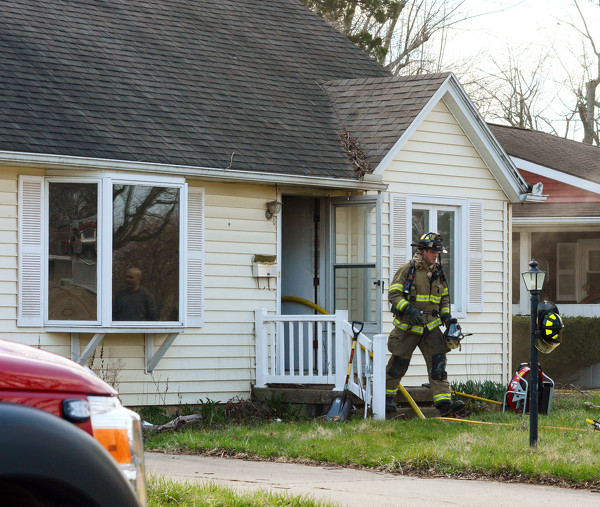Wednesday, April 6th, 2022
Officials from 7 counties discuss bird flu
Disease so far not detected in the area
By William Kincaid
CELINA - Mercer and surrounding counties are home to millions of turkeys and chickens and thus susceptible to Highly Pathogenic Avian Influenza (HPAI) that has been detected in northwest Ohio.
Bird flu, if introduced locally, could have economically devastating impacts on poultry production, attendees learned during a Tuesday morning session hosted by the Mercer County OSU Extension.
The virus predominantly spreads by wild birds when they migrate in the spring and fall, county OSU Extension educator Denny Riethman had said. The virus is transmitted by droppings or direct contact with an infected bird. There is no evidence humans can get the virus, he said.
"We do know that avian influenza is here (in Ohio). It is over us per se as the migratory birds are continuing to fly. It is something that we are doing a lot of surveillance on," said Dennis Summers, state veterinarian and chief of Division Of Animal Health at the Ohio Department of Agriculture.
About 20 government and agriculture officials from a seven-county region met at the Central Services Building in Celina to hear updates on and learn how to respond to HPAI from a panel of animal health experts who spoke remotely via teleconference.
So far it appears enhanced biosecurity measures have proved successful in warding off bird flu in poultry flocks, Summers said.
"We do know that we have positive wild birds across the state of Ohio," said Susan Skorupski, a veterinarian with USDA. "To the credit of the people in Ohio they have so far been doing a great job of not letting that virus come in, not walking it in with their shoes or clothes or their equipment. They can't let up."
HPAI status in Ohio
HPAI was detected early last week in a poultry flock in western Franklin County, Summers noted. It has also been detected in wild birds in Erie, Ottawa and Sandusky counties, he said.
"That was the first confirmation in backyard or poultry flocks in our state of Ohio," Summers said of the Franklin County case. "Previously the last couple of weeks we have had detections in wild birds. We've been monitoring correspondence from USDA's Wildlife Services and the Ohio Department of Natural Resources."
The Franklin County occurrence involved a small family operation that doesn't sell products, Summer said, characterizing it as more of a small hobby farm.
"That was a backyard flock. There were 15 total birds. They had seven that died initially and they had another one die before we could go out and finish depopulating that premises," he said.
The experience was positive in that the producer was educated, knew something was not right with the birds and called in state officials, he said. A state and federal cooperative team quickly moved to depopulate (euthanize) the birds with carbon dioxide per USDA guidelines.
The premises had high risk issues that state officials believe were the main reason behind the infection.
"They did have some free range access and they also had a small pond on the back of their property and there was a recent introduction of (wild) ducks flying and landing in, around that pond about two weeks prior to the birds becoming ill and dying," he said.
That timeframe, Summers said, corresponds to an incubation period.
"We do know that there was that potential contact and we think that was the most likely source of introduction," he said.
The site continues to be monitored as part of a 6 kilometer surveillance zone in accordance with USDA guidelines.
"We're going to do that for about two weeks after the depopulation event. So long as we don't have any new detections in the surveillance zone we will have completed our obligation for surveillance within that zone," Summer said, adding officials will reach out to other nearby producers and increase testing.
The Franklin county case as of Tuesday remained the only known detection of HPAI in Ohio poultry operations.
State officials have communicated to commercial poultry operators and organizations about the threat of HPAI. Now they're casting their nets even further.
"We continue to try to find any avenue to reach smaller operations that would not qualify as commercial in the definition but really targeting 4-H, backyard (flocks)," Summers said. "We're approaching fair season. We want to make sure that we stress the importance (of biosecurity) and we ask that you all participate and help us out in any way to share this message."
Enhanced biosecurity is the single most important practice keeping avian influenza from infecting poultry flocks, Summers stressed.
"Ohio is doing those activities right now to protect their flocks," he said.
How HPAI spreads, symptoms
Skorupski said HPAI-positive, migrating wild birds fly over and stop in certain places, potentially spreading disease.
"All these birds that are flying here … they leave a present as they fly over or stop in to visit their friends," she said.
That's why biosecurity is so important, starting with making sure people entering animal buildings have clean footwear so they don't inadvertently introduce a pathogen. That means anyone, including employees, electricians, other contractors and state officials.
ODA, per its website, urges poultry owners to follow other important biosecurity measures and best practices, such as keeping birds indoors when possible; keep visitors to a minimum; wash hands before and after contact with live poultry; provide disposable boot covers and/or disinfectant foot-baths for anyone having contact with the flock; establish a rodent and pest control program; use drinking water sourced from a contained supply such as well or municipal system; clean and disinfect tools and equipment before moving them to a new poultry facility; look for signs of illness and report sick birds to ODA.
Symptoms can include discoloration and/or swelling of legs, wattles and combs; labored breathing and reduced feed and water consumption, the website indicates.
"Sometimes you're just going to have dead birds. That's all you're going to see," Skorupski said. "The first case they reported that the house was quiet or a significant decrease in water consumption."
Responding to bird flu
Skorupski described the response to bird flu in the event it's detected. A summary of the multi-step process is outlined in a guide provided by USDA and listed below.
• Detect - Producers who see unusual signs of illness or sudden deaths in their flock can report observations to a private, state or USDA veterinarian. Samples are taken and tested.
• Quarantine of operations - USDA and state personnel come to the operation. A case manager is assigned to answer questions and guide the poultry owner through paperwork. The operation is placed under quarantine, meaning only authorized workers are allowed in and out, and movements are restricted for poultry, poultry products and equipment. Neighboring poultry farms are contacted and their birds are tested.
• Appraise - Officials work with the owner to create a flock inventory listing number of birds, species, age and other key details. USDA will compensate for birds that must be destroyed using species-specific calculators.
• Depopulate - Infected flocks are depopulated as quickly as possible, ideally within 24 hours of the first HPAI detection.
• Compensate - Affected producers and growers must certify that a biosecurity plan was in place prior to an HPAI detection. Split payments can be provided between the owner and contract grower.
• Manage disposal - USDA will help dispose of dead birds safely by means of composting, burial, incineration, rendering or landfilling.
• Eliminate virus - Wipe out all traces of the virus at the property by thoroughly cleaning and disinfecting the barn, equipment and all affected areas of the farm. This can be done by the owner or hired contractors.
• Test - Once cleanup is complete, the site must stay empty for at least 21 days, during which environmental samples will be collected and tested.
• Restock - Once USDA and the state both approve, the owner can restock the facilities and start production again. State officials will release the the farm from quarantine after all required testing and waiting periods are done.
• Maintain biosecurity - After restocking, owners must continue maintaining the highest biosecurity standards to keep the virus from coming back.


